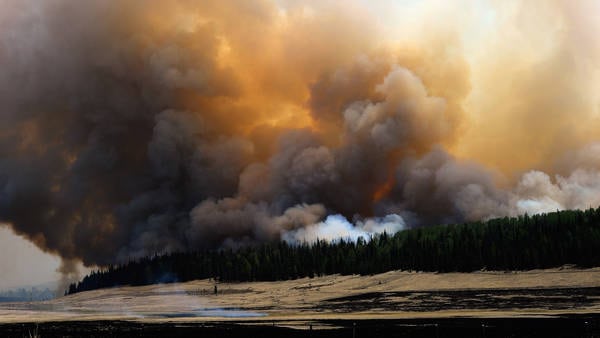Wildfires and Bugs
Stripping the bark of a tree with a hatchet, Diana L. Six, a University of Montana insect scientist, pointed out the telltale signs of infestation by pine beetles: channels drilled by the creatures as they chewed their way through the juicy part of the tree.
The tree she was pointing out was already dead. Its needles, which should have been deep green, displayed the sickly red that has become so commonplace in the mountainous West. Because the beetles had cut off the tree’s nutrients, the chlorophyll that made the needles green was breaking down, leaving only reddish compounds.
Pine beetles are a natural part of the life cycle in Western forests, but this outbreak, under way for more than a decade in some areas, is by far the most extensive ever recorded. Scientists say winter temperatures used to fall to 40 degrees below zero in the mountains every few years, killing off many beetles. “It just doesn’t happen anymore,” said a leading climate scientist from the University of Montana, Steven W. Running, who was surveying the scene with Dr. Six one recent day.
As the climate has warmed, various beetle species have marauded across the landscape, from Arizona to Alaska. The situation is worst in British Columbia, which has lost millions of trees across an area the size of Wisconsin.
The species Dr. Six was pointing out, the mountain pine beetle, has pushed farther north into Canada than ever recorded. The beetles have jumped the Rocky Mountains into Alberta, and fears are rising that they could spread across the continent as temperatures rise in coming decades. Standing on a mountain plateau south of Missoula, Dr. Six and Dr. Running pointed to the devastation the beetles had wrought in the forest around them, consisting of a high-elevation species called whitebark pine.
“We were going to try to do like an eight-year study up here. But within three years, all this has happened,” Dr. Six said sadly.
“It’s game over,” Dr. Running said.
Later, flying in a small plane over the Montana wilderness, Dr. Running said beetles were not the only problem confronting the forests of the West.
Warmer temperatures are causing mountain snowpack, on which so much of the life in the region depends, to melt earlier in most years, he said. That is causing more severe water deficits in the summer, just as the higher temperatures cause trees to need extra water to survive. The whole landscape dries out, creating the conditions for intense fires. Even if the landscape does not burn, the trees become so stressed they are easy prey for beetles.
From the plane, Dr. Running pointed out huge scars where fires had destroyed stands of trees in recent years. “Nothing can stop the wildfires when they get to this magnitude,” he said. Some of the fire scars stood adjacent to stands of lodgepole pine destroyed by beetles.
At the moment, the most severe problems in the nation’s forests are being seen in the Southwestern United States, in states like Arizona, New Mexico and Texas. The region has been so dry that huge, explosive fires consumed millions of acres of vegetation and thousands of homes and other buildings this summer.
This year’s drought came against the background of an overall warming and drying of the Southwestern climate, which scientists say helps to explain the severe effects. But the role of climate change in causing the drought itself is unclear — the more immediate cause is an intermittent weather pattern called La Niña, and research is still under way on whether that cycle is being altered or intensified by global warming, as some researchers suspect. Because of the continuing climatic change, experts say some areas that are burning this year may never return as forest — they are more likely to grow back as heat-tolerant grass or shrub lands, storing far less carbon than the forests they replace.
“A lot of ecologists like me are starting to think all these agents, like insects and fires, are just the proximate cause, and the real culprit is water stress caused by climate change,” said Robert L. Crabtree, head of a center studying the Yellowstone region. “It doesn’t really matter what kills the trees — they’re on their way out. The big question is, Are they going to regrow? If they don’t, we could very well catastrophically lose our forests.”
A couple of thoughts..
It’s interesting to me that people are predicting that trees are “on their way out”. I wonder specifically what evidence is there for this? I wonder about what I call the “pontification to data ratio” of some of these observations.
It’s also interesting when people use the term “devastation” to describe mountain pine beetle killed forests. Because “natural” cycles vs. “climate change induced” cycles look exactly the same (acres of dead trees).

